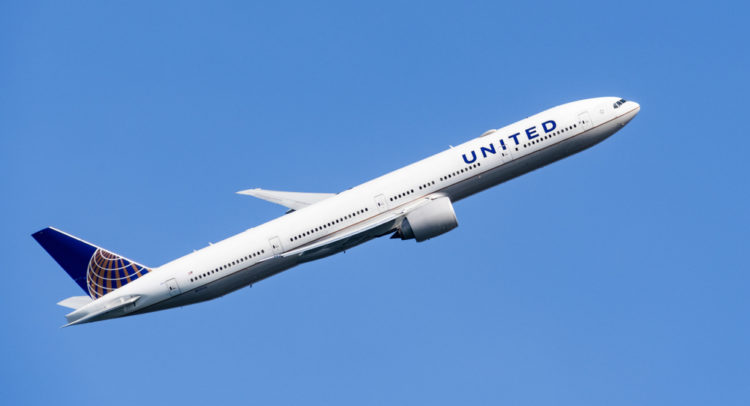United Airlines Holdings, Inc. (NASDAQ: UAL) has missed the top and bottom-line consensus estimates for the first quarter of 2022. Despite the shortfall, shares of this $15.2-billion American airline took off on the back of impressive year-over-year comparisons and solid projections for the second quarter of 2022.
Discover the Best Stocks and Maximize Your Portfolio:
- See what stocks are receiving strong buy ratings from top-rated analysts.
- Filter, analyze, and streamline your search for investment opportunities with TipRanks’ Stock Screener.
Shares of United Airlines rose 1.2% to close at $46.52 on Wednesday. At the time of writing, an incremental gain of 8.36% was recorded in the share price.
Financial Highlights
United Airlines reported an adjusted loss of $4.24 per share in the first quarter, better than the $7.50 loss per share recorded in the year-ago quarter. However, the quarterly loss was higher than the consensus loss estimate of $4.21 per share.
Revenues stood at $7.57 billion, up 134.9% from the year-ago quarter but below the consensus estimate of $7.68 billion.
Passenger revenue in the quarter rose 174.1% to $6,348 million, while Cargo sales at $627 million were up 26.2%. Other operating revenues in the quarter were $591 million, up 44.9% year-over-year.
In the quarter, passenger count increased 99.9%, and revenue passenger miles (RPM) grew 124% year-over-year. Total revenue per available seat mile (TRASM) advanced 33.8% from the year-ago quarter. Exiting the quarter, the aircraft fleet size expanded 1.7% to 1,343.
Non-GAAP cost per available seat mile (CASM) decreased 25.3% year-over-year to $12.55. Average aircraft fuel price per gallon rose 65.25% year-over-year, and fuel gallons consumed were up 58.2%.
Adjusted operating expenses in the quarter increased 31% year-over-year to $6,686 million. Adjusted operating margin was (18.3%) versus (85.6%) in the year-ago quarter, and adjusted earnings before interest, tax, depreciation, and amortization margin were (9.9%), better than (65.4%) in the year-ago quarter.
Balance Sheet and Cash Positions
Exiting the quarter, United Airlines’ cash and cash equivalents were $18.5 billion, up 1% from the previous quarter. On the contrary, the company’s long-term debts decreased 2.3% sequentially to $29.7 billion. During the quarter, the company repaid debts amounting to $783 million.
Cash flow from operations surged 230.2% year-over-year to $1,476 million. Capital expenditures at $402 million were down 9.5% from the year-ago quarter.
Q2 Projections
United Airlines anticipates TRASM in the second quarter to reflect an increase of 17% over 2019. This is the company’s strongest top-line forecast ever.
Profitability seems achievable in the quarter with an operating margin expected to be roughly 10%. Cost headwinds due to the increase in fuel prices remain concerning. The average aircraft fuel price per gallon is expected to be $3.43 (versus $2.88 in the first quarter).
For 2022, the company expects to report profits as the airlines benefit from higher traveling demand across the globe.
Official Comment
United Airlines’ CEO Scott Kirby opines that the second quarter of 2022 “will be a historic inflection point” for the business.
“The demand environment is the strongest it’s been in my 30 years in the industry – and United and its customers will benefit more than any other airline,” he added.
Stock Rating
Three days ago, UBS analyst Myles Walton downgraded the rating to Hold from Buy on United Airlines. However, Walton maintained the price target at $51 (9.63% upside potential).
He opined that United Airlines “could benefit from strong pricing power in the second quarter” but might feel the pressure on its margins.
Overall, United Airlines has a Hold consensus rating based on three Buys, seven Holds, and three Sells. United Airlines’ average price target of $49.92 mirrors 7.31% upside potential from current levels. Over the past year, shares of United Airlines have declined 10.3%.
Investors’ Sentiment
Per TipRanks, Investors’ sentiment is currently Very Negative for United Airlines, as 1.4% of investors on TipRanks have lowered their holdings in the stock in the past seven days.

Conclusion
Spike in fuel prices is a major hurdle for airline companies in the United States. Though the issue can be managed easily by passing on the burden to the passengers (in the form of higher fares), it can impact travel volumes and margins.
The findings by the Adobe Digital Economy Index reveal that online booking for domestic traveling has decreased 2% in the first two weeks of April versus the second half of March.
Notwithstanding this setback, United Airlines seems to be progressing well to return to pre-COVID levels.
Discover new investment ideas with data you can trust.
Read full Disclaimer & Disclosure
Related News:
Tesla Q1 EPS Up by 250%, Shares Gain Over 7%
Steel Revenues Solidify Steel Dynamics’ Q1 Results
Lazydays’ Preliminary Q1 Results Impressive









